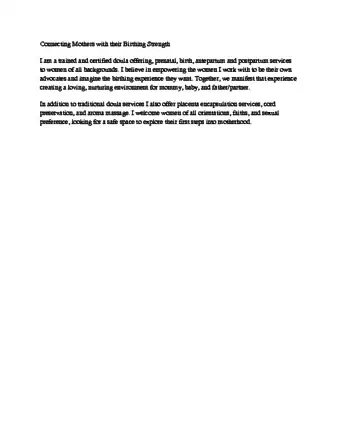wikiHow is a “wiki,” similar to Wikipedia, which means that many of our articles are co-written by multiple authors. To create this article, 25 people, some anonymous, worked to edit and improve it over time.
There are 9 references cited in this article, which can be found at the bottom of the page.
wikiHow marks an article as reader-approved once it receives enough positive feedback. In this case, 100% of readers who voted found the article helpful, earning it our reader-approved status.
This article has been viewed 121,098 times.
Learn more...
A doula offers support to mothers before, during and after they give birth. Doula literally means “a woman who serves,” and doulas have been support givers for centuries. Today, doulas are trained professionals who are highly regarded for their professional expertise.[1] There are a variety of doulas, from birth doulas, post-partum doulas, to miscarriage doulas. If you want to join the ranks of this exciting profession, then it's important to find the right path for you. See Step 1 to learn how to get started with becoming a doula.
Steps
Getting Started
-
1Decide which type of doula you want to be. The most common type of doula is the birth doula, though there are a variety of other types of doulas as well. Many doulas specialize in more than one area, though it's important to decide on which doula you most want to be so you can become an expert in your field. Here are the varieties of doulas that you can choose from:
- Birth doula. The birth Doula's goal is to support a mother and her family throughout the birth process. This includes giving emotional encouragement, teaching about birth, giving massage and physical support during labor, and coaching breathing techniques and labor positions. Birth doulas typically visit their families 1-2 times before and after birth.
- Antepartum doula. These doulas commonly serve women who are having high-risk pregnancies or who are placed on bed-rest. They offer emotional support and sometimes even help with cooking and light housework.
- Postpartum doula. This type of doula helps new mothers learn to breastfeed their children, gain an understanding of normal infant sleep cycles, or calm them down. They offer information, support, and sometimes even help out around the house.
- Adoption doula. An adoption doula often works with both the birth mother and the adoptive family to offer emotional support and to ensure a smooth transition for the child as well as both mothers and families.
- Miscarriage/loss doula. These doulas help families deal with miscarriage and offer physical end emotional support throughout the process.
-
2Consider getting formal doula training. While it's not mandatory to be formally trained as a doula, this step is important for building your skills as a doula, and for giving you a solid base to work from. In a training program, you'll learn more about the intricacies of childbirth and will supplement your knowledge with videos and readings. You will also learn about labor support, finding clients, and even how to start your own business. Look for legitimate organizations in your area and commit to working with other inspired doulas and learning the ins and outs of your profession.[2]
- You can be trained at a location of DONA International, International Doula Institute, International Childbirth Education Association (ICEA), Lamaze International, or to Labor (The Organization of Labor Assistants for Options & Resources).[3] [4]
- As you choose your training program, you should not only make sure that it is reputable, but that it gives you what you're looking for. You should consider the philosophy of the particular program, the depth and length of the training, as well as the cost — it can cost $500 or more. Don't let cost stop you, however, and make sure you look into scholarship programs before turning down a program because of cost alone.
Advertisement -
3Consider getting certified. Though certification isn't necessary, it does help you gain knowledge and move forward in your career. One of the reasons doulas are criticized is because of their lack of formal or medical training, and being certified will help you dispel some of these myths. Though training can be enough and you may also find an apprenticeship or mentorship program, you should consider getting certified through a program such as DONA International or International Doula Institute. Here are some of the perks:[5] [6]
- Gaining knowledge. You'll have more opportunities to learn about the different aspects of being a doula, from connecting with clients to helping them breastfeed.
- Gaining credibility.
- Being listed in a database that allows you to be more easily found by clients.
- Becoming more marketable to new clients. You'll be more likely to be trusted if you have some paperwork to back up your expertise.
Getting Certified
-
1Choose a doula organization that is right for you. Some of the most popular certification organizations are International Doula Institute, DONA International, CAPPA and BirthArts. You can explore options in your area and see what's the best fit for your vision of your career. In order to make your decision, you'll need to look into the certification requirements of different organizations. If you are interested in DONA, then you should read the position papers, Standards of Practice and the Code of Ethics of the organization.[7] To learn more about International Doula Institute, read their What is a Doula section.[8] .
-
2Become a member of a doula organization. Some organizations require you to pay a membership fee before you can start the training program or attend a workshop. You can join DONA International or another organization. You'll have to fill out some paperwork and to pay a fee. This is a necessary step to being able to move forward and benefit from the organization.
-
3Attend a workshop. Contact DONA International[9] or International Doula Institute[10] , or the organization you're interested in to find out where you can attend a workshop either in person or online; the first step you need to take in order to get your certification as a doula. Though workshop requirements vary by program, the workshop requirements for DONA are:
- 16 hours of workshop instruction.
- 12 hours of childbirth education classes (you may substitute a 7-hour DONA approved “introduction to childbirth for doulas course” in place of the childbirth education series).
- Read a minimum of 5 books from DONA’s required reading list. You can download the required reading list from the website.
-
4Purchase a certificate packet. Each organization will have a certificate packet for you to purchase. For DONA International, for example, the certificate package will be about $45 and will be date stamped so that you are allowed 2 years from that date to complete all the certification requirements. You can purchase the certificate packet any time you like, but you must complete the certification requirements no longer than 4 years after you have completed the workshop.
-
5Fulfill the requirements of your organization. The requirements you'll need to fulfill will depend on the program you've chosen, and some exceptions will be made for doulas who live further away from approved educators. For DONA, for example, you'll need to fulfill at least one of the following requirements:
- Observe a complete childbirth preparation series (not as an expectant parent).
- Attend an “Introduction to Childbirth for Doulas” class that is offered in conjunction with an approved workshop.
- Train in midwifery or childbirth education.
- Perform work experience in labor and delivery as a registered nurse (RN).
-
6Submit proof of completion of the requirements of your program. For DONA, you'll need to prove that you completed at least one of the following requirements:
- Lactation consultant, breastfeeding peer counselor or community breastfeeding educator
- Completion of 1 approved online course in breastfeeding basics or lactation education resources
- Completion of a 3-hour breastfeeding workshop that is taught by an educator with proper credentials (IBCLC, CLE or CLC)
-
7Provide doula service for the required number of clients. For DONA, you'll need to provide the details of doula service for 3 clients, though the requirements will vary program by program. All birth details cannot be submitted until after all other workshop and certification requirements have been met. For DONA, your doula service for the 3 clients must include all of the following:
- Labor support before or at the onset of active labor
- Labor support of at least 15 hours total
- Continuous presence at the labor and birth
- Postpartum support
- Documentation of vaginal examinations on the birth record sheet’s labor progression chart
- Inclusion of a client confidentiality release form, DONA International birth record sheet, typewritten account of each birth (500 to 700 words), evaluation from each client and each client’s primary caregiver
- A list a of at least 45 local resources in at least thirty 30 different categories
- A signed copy of the DONA code of ethics and standards of practice
- Provide full contact information for 1 client and 1 birth professional who agree to serve as references for you
- Submit a typewritten essay (500 to 1,000 words) about the value and purpose of labor support
- Provide a check for the certification processing fee
-
8Get your certification. Once you've completed the required training and experience requirements for your organization, you'll have to mail your documents to the organization and should receive your certification. You can use this to help you find future clients and to make yourself a more appealing candidate before you go on the job.
Going on the Job
-
1Look for clients. Once you've completed your training, and possibly your certification, it'll be time to start looking for clients. This can be a bit of a challenge when you're starting out, though being listed in a database of an organization can definitely help. You can talk to other doulas, let people in your area know that you're ready for business, make business cards and ask if you can give them out at childbirth or labor support classes.
- Your training or certification program should be able to help you, but you'll still need to be patient.
- Your clients will most likely not book you after speaking to you over the phone. You'll need to go to their homes or meet with them during an interview process so they can make sure they can trust you.
-
2Be physically strong. Physical strength is important, especially if you're a birth doula. You'll need to be strong in order to give women who are in labor direct support, from helping turn them over in bed to helping them assume different labor positions. Stamina is just as important as strength. Labor can last many hours, or even days, and you'll need to not only be strong, but to be able to be energetic, alert, and enthusiastic throughout the process, no matter how long it takes.
- Even if you're not a birth doula, you may need your strength to help women out around the house or to help women change positions after labor.
-
3Be able to easily connect with your families. Families want their doulas to be trustworthy, emotionally engaging, and a source of support and comfort. If you want to make the commitment to help a family throughout the birth process, then you'll need to be able to instantly show them care, love, and support. You have to be able to focus on the family and to push your ego aside, but to also be strong and assertive in order to advocate for the family's needs.
- You'll also need to know how to be kind and loving with both the birth mother and her baby, and to continue to give the family your love and support.
- It's important to be able to form emotional connections with the families you work with, while maintaining your objectivity and doing what's best for the birth mother and her baby.
-
4Be prepared for the flexible lifestyle. A doula does not work a typical 9-5 day. Most doulas, especially birth doulas, should be prepared for a very flexible schedule and lifestyle. When you're working with a birth mother and she needs you, you'll be expected to drop what you're doing to be by her side. You won't be able to take too many last-minute vacations or to spend a weekend getting "me time" very often. If you have another job to supplement your income, then that job should be pretty flexible, to make it easy for you to help the birth mother when she needs you.
- Your own family life should also be pretty flexible. You'll need to be able to leave home at a moment's notice, and to have someone to look after your children, if you have any.
- If you're an antepartum, postpartum, or another doula, then your schedule may be a bit more regular, though being available is always a must.
- Having a flexible schedule will also make you a more desirable candidate for families.
-
5Be on call. A doula can't be found with a dead cell phone. You'll need to have your phone at your side so you can call clients to check in to see how their doctor visits went, take calls from clients who need advice, or get calls from clients who are going into labor and who need you by their sides ASAP. You'll need to be responsible and to manage your time well and to be prepared to completely change your schedule at a moment's notice.
- You'll also need to have a soothing and calm manner over the phone, since many of your clients will be calling you seeking reassurance. You'll need to tell them that everything will be all right and to offer advice and comfort, especially if you're on your way over and want your clients to stay calm until you arrive.
-
6Get support from other doulas. Being a doula is incredibly rewarding, but it can be emotionally draining as well. It'll help to get support from other people in your profession. You can join a doula group in your area, check out professional newsletters, or even find help in online forums. You can seek advice or just feel the comfort that other people in your profession are feeling the same way you are.
- Getting support from other doulas can also help you tackle tricky situations with families or can just give you practical tips for improving your work.
-
7Consider supplementing your income. On average, doulas make below $30K a year, and you may want to supplement your income by providing additional services for families. Here are some things you can do to make ends meet:
- Lactation counseling. Help families learn the intricacies of successful breastfeeding.
- Placenta encapsulation. This is the process of drying and then powdering the afterbirth of the baby to create capsules that the mother can eat. Some say that this has tremendous physical and emotional benefits for the mother.
- Childbirth education classes. You can share your knowledge in classes with expectant parents. These classes can also help you advertise your services.
- Photography. You can also take photographs of the happy families and their newborn children.
- Belly casting. You can create a mold of the mother's pregnant belly for the family to keep as a memory of this exciting time.
Sample Doula Mission Statement
Warnings
- You cannot be listed on the DONA International website (for referrals) unless you maintain active membership status in DONA.⧼thumbs_response⧽
References
- ↑ http://www.dona.org/mothers/index.php
- ↑ http://radicaldoula.com/becoming-a-doula/
- ↑ http://www.dona.org/aboutus/index.php
- ↑ www.internationaldoulainstitute.com/doula-training/
- ↑ http://radicaldoula.com/becoming-a-doula/
- ↑ www.internationaldoulainstitute.com/doula-training/
- ↑ http://www.dona.org/develop/certification.php
- ↑ http://internationaldoulainstitute.com/what-is-a-doula/
- ↑ http://www.dona.org/develop/find_a_workshop.php
About This Article
If you want to become a doula, first decide which type of support you want to offer, such as a birth doula to support a family through childbirth, or a postpartum doula to help new mothers care for their baby. Once you have an idea of your desired career, take a doula training program with a reputable organization, like DONA International or the International Doula Institute. After you’ve completed the course, consider getting certified, which will assist you in getting jobs later on. If you decide to do this, you'll need to pay a certification fee to your chosen organization, like DONA. Then, complete the certification requirements, which can include observing a child birth, performing work experience as a registered nurse, or offering doula services to 3 clients. When you’ve completed all of the requirements, mail your documents to your organization to obtain your certification. For tips on how to set up your own business as a doula, read on!

















































































Medical Disclaimer
The content of this article is not intended to be a substitute for professional medical advice, examination, diagnosis, or treatment. You should always contact your doctor or other qualified healthcare professional before starting, changing, or stopping any kind of health treatment.
Read More...